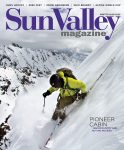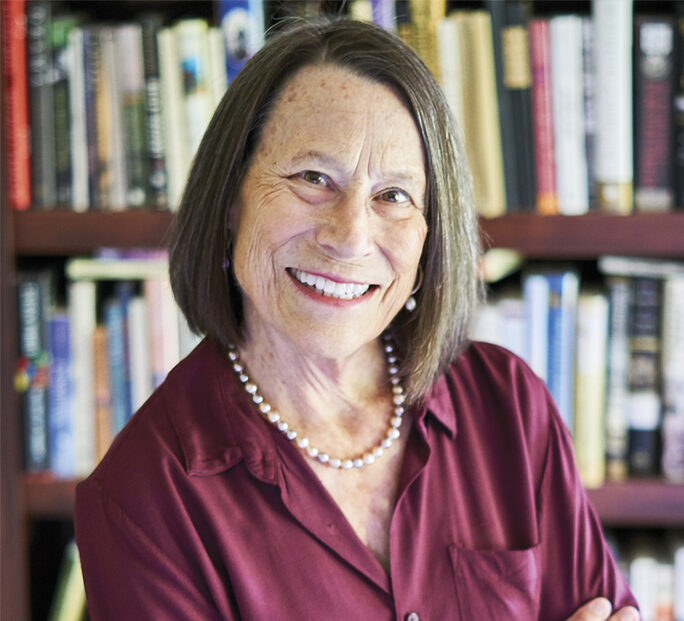Sun Valley resident Louisa Cook Moats, EdD, is known as one of the nation’s leading authorities on literacy and how children learn to read. Throughout her career, she has been a researcher, teacher, psychologist, graduate school faculty member, and author of numerous scientific journal articles, books, and policy papers, reading, spelling, language, and teacher preparation.
Her path to this prestigious station began with a college degree in music and a stint in secretarial school, learning how to type. According to Dr. Moats, she was attending Wellesley College as a music major and didn’t have a clear idea of a future career. So, she enrolled in secretarial school to learn typing and shorthand and soon thereafter was hired in a neuropsychology laboratory to type reports. After about eight weeks, the clinic supervisor gave her a white coat and said he would train her as a lab technician. She began giving neuropsychological tests to adults and children, and her interest in teaching students with learning disabilities was soon sparked.
Moats went on to earn her M.A. in special education at Peabody College of Vanderbilt. However, after graduating, she still felt unprepared to teach students with reading, spelling, and language difficulties as the field was still so new. After years of working in various education-related jobs, she applied to the Harvard Graduate School of Education where she earned her doctorate in reading and human development. It was there that she learned the basics of research design, analysis of evidence, and statistics.
Understanding LETRS
Among Moats’ major contributions in the field of literacy is LETRS, or “Language Essentials for Teachers of Reading and Spelling,” a professional development program that helps educators understand how students learn to read and write, recognize the reasons why some students struggle, and determine what must be taught to increase student success. It builds teachers’ knowledge of language structure and the processes involved in learning to read, spell, and comprehend, and then apply that understanding in their classrooms. Published in 2001, LETRS is now being used by about 300,000 teachers nationwide.
“LETRS in its present form is a result of about 30 years of work, figuring out how to get teachers to teach kids to read, and what reading science tells us about how to get good results with kids,” said Moats.
Moats created the prototype for LETRS in the early 1990s as graduate courses for teachers earning master’s degrees at Saint Michael’s College in Colchester, Vermont. At the time, she worked as a psychologist specializing in language-based learning disorders and conducting evaluations on people with dyslexia and other learning difficulties. She realized that the teachers receiving her reports rarely had the background, training, or support to apply the recommendations, which often called for explicit teaching of language skills, including phoneme awareness, phonics, spelling, vocabulary, syntax, text reading comprehension, and writing.
“My studies showed that teachers were not being prepared to teach in a way that would likely prevent or ameliorate difficulties in the crucial early stages of learning,” said Moats. “I saw the need to focus on language essentials because very few teachers ever get solid training in the content necessary to teach well.”
She later offered these graduate courses during the 1990s and into the 2000s at the Greenwood Institute in Putney, Vermont, and at Simmons College (now Simmons University) in Boston, where she and her colleagues taught graduate students. The courses were also adapted for teachers in the Washington, DC, Early Interventions Project, where she directed a project for the National Institutes of Child Health and Human Development (NICHD) working with inner-city teachers and children in high-poverty schools. The students’ reading achievement rose significantly, and the professional development program was instrumental in both teacher and student growth.
“We demonstrated that even in those schools, with those kids, we could teach them how to read,” she said. “That was a real life-changing experience for me to understand that the problem was not the children; the problem was the adults.”
Working With Dyslexia
“In my first job in a neuropsychology clinic (in the 1960s), we evaluated kids with reading and writing disabilities. They were suffering, and we didn’t know how to help them. We had no name for their condition, at least one that I thought was valid.
“Then, when I was studying reading and language in my doctoral program in the 1970s, I learned what dyslexia really was—a language-based learning disability that affected between 5 and 20 percent of the population. I started publishing my own studies of kids and their teachers in journals devoted to understanding dyslexia.”
Moats said that during her career, she has had to change her thinking about dyslexia many times. “I was surprised that through neuroscience, we could actually see the brain’s activation patterns and how they change in response to instruction. And I was surprised to learn how complex a condition is, with multiple causes, symptoms, and no simple profile that would be a “classic case.” I wanted there to be a clearly defined syndrome, and the more I learn from research, the more I see that’s not true.”
She served on the International Dyslexia Association board for many years, edited their publications, and wrote standards for teacher training that are now widely used and referenced. She was also recruited to write the Idaho Dyslexia Handbook, which the Idaho Board of Education adopted in 2022.
“However, in the last 20 years, I’ve focused more on regular classroom teaching and the prevention of reading difficulties because we have a much better chance of helping kids avoid devastating downward spirals if we catch them early in Pre-K or K,” she notes.
For her work in the field of dyslexia, Moats received the prestigious Samuel T. and June L. Orton Award from the International Dyslexia Association® for outstanding contributions to the field.
Retired, But Not
Moats said she is retired but “still busy and keeps her hands in a lot of programs,” including as secretary of the board of The Space, the Hailey non-profit offering after-school and summer programming for middle and high school kids, and as an officer of the Wood River Women’s Foundation.
“I encourage state efforts here in Idaho, such as the Sun Valley Early Literacy Summit at the Ketchum Community Library and the State of Idaho SMART project,” she said. Her textbook, Speech to Print, came out in 2020 and became the basis for Idaho’s SMART Project — Striving to Meet Achievement in Reading Together—a statewide teacher training program adopted in 2021.
Jenny Davidson, Executive Director of the Ketchum Community Library and founder of the Sun Valley Literacy Summit, calls Moats “an inspiration.”
“I admire Louisa Moats greatly, and I know that more children are learning how to read in Idaho as well as across the country because of her persistent march, her dedicated work, and helping all educators understand how reading happens in the brain,” Davidson said.
“What Louisa’s done in the field of literacy and how she has carried that forward to Idaho has been tremendous. She has helped shape the educational policies in the state, from the Idaho comprehensive literacy plan to the Idaho Dyslexia Handbook, all of which provide meaningful guides to how reading can happen.”
Three years ago, Davidson approached Moats with the idea of hosting a seminar for Idaho teachers on the science of reading. She was enthusiastic and willing to lend her expertise and connections to make it happen.
“She connected the library to several preeminent literacy scholars in the nation, and because of Louisa’s esteemed background, they were willing to participate in the symposium and shape something that hadn’t happened before in the state. That was the birth of the Sun Valley Early Literacy Summit, and Louisa was a key inspiration behind it,” Davidson said.
“Louisa emanates such grace and good humor even as she has faced what has oftentimes been discouraging,” added Davidson. “Yet rather than being deflated, she has continued on, and her quiet, graceful, good-humored, and fierce persistence has provided relief to parents who have children with dyslexia, inspiration to teachers who want all of their students to flourish and is helping to create an environment in Idaho and the nation where every person could enjoy the richness that comes from simply being able to read.”
Sun Valley Living
“I moved here in 2004 with my husband Steve Mitchell, who I married in 2003,” said Moats. “He had a longer-term relationship with the Valley, as he already had a house here when I met him, and in the early 1990s, he had owned a bookstore in Ketchum called the Main Street Book Store and Café. He was a publisher, and the publishing company he worked for recruited me to write LETRS in 2001.”
She embraced the winter wonderland and learned to ski soon after moving here. “My daughter was an extreme skier, and her husband was a downhill racer on the U.S. Ski Team, and I was surrounded by skiing, so I decided I had to learn. I signed up for Mountain Masters for a few years, but now I am taking it a bit easier,” saying she still enjoys Nordic skiing, “and I have two grandchildren, who, fortunately, love to read and love books!”
Today, in her “retirement,” Moats golfs, or as she says, “I play golf a little bit, badly! I have a bike and work out at the Y, and I hike.” However, she refuses to reveal her favorite hiking trail, saying with a laugh, “I won’t tell because more people will use it, and it’s my private Idaho right now.
“Now, I turn my attention to the local efforts to improve education for kids here in the Valley. I want to do what I can from the sidelines to make sure that Blaine County capitalizes on reading science and lifts up the kids here. They’re already doing a lot, but there is a lot of work to be done and I’m just keeping my hand in where I can to help steer things in the right direction.”


